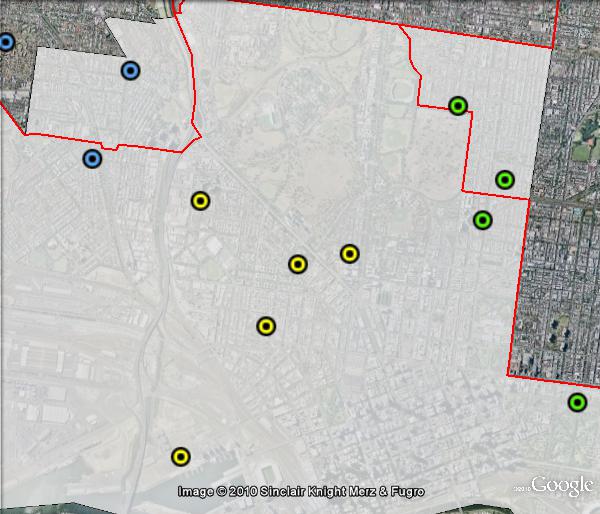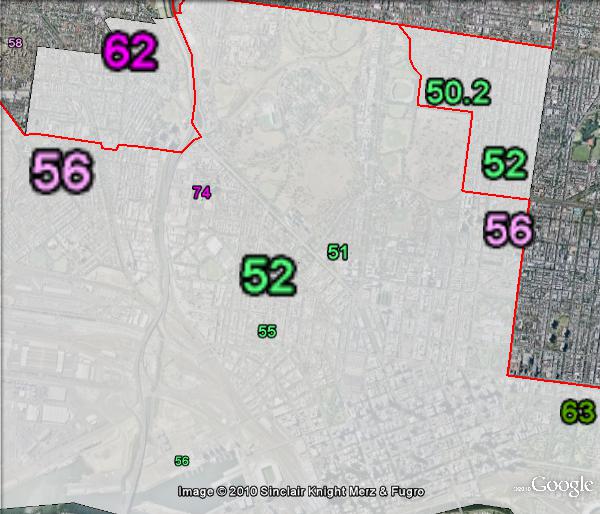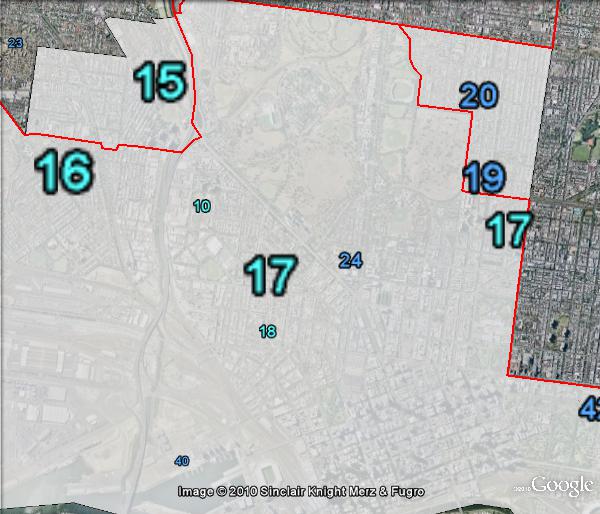ALP vs GRN 2.0%
Incumbent MP
Bronwyn Pike, since 1999.
Geography
Inner Melbourne. The seat of Melbourne covers the Melbourne CBD and surrounding areas. It covers all parts of the City of Melbourne north of the Yarra River, as well as small parts of Moonee Valley and Yarra council areas. Melbourne covers the suburbs of Carlton, Carlton North, East Melbourne, Flemington, Kensington, Newmarket, North Melbourne, Parkville, West Melbourne and parts of Ascot Vale.
History
There was a district with the name “Melbourne” in the original Victorian Legislative Assembly at the 1856 election, before being abolished in 1859. It was recreated in 1889 as a single member district that has existed ever since. The seat has a long history of being held by the ALP, who have held it continously since 1908.
The recreated Melbourne district was won by Geoffrey Carter in 1889, and was won in 1900 by Labor candidate Edward Findley. Findley was expelled in 1901 for seditious libel after publishing an Irish article criticising the King in a radical union newspaper that he edited. He lost the following by-election, but went on to serve in the Senate from 1903 to 1917 and again from 1922 to 1928.
The 1901 by-election was won by Conservative candidate James Boyd, who supported conservative state governments, including serving as a minister from 1907 to 1908, when he stepped down. He was elected as a federal Liberal MP in 1913 and served until his defeat in 1919.
Melbourne was won by Labor candidate Alexander Rogers in 1908. He held the seat until 1924. He was succeeded by Thomas Hayes, who held the seat until 1955. That year, he left the ALP and joined the new ALP (Anti-Communist), the precursor to the Democratic Labor Party, but was defeated at the 1955 election.
The seat was then held by the ALP’s Arthur Clarey from 1955 until 1972. In 1972, Melbourne was won by the ALP’s Barry Jones. He held the seat until 1977, when he resigned to run for the federal electorate of Lalor, which he held until his retirement in 1998. He served as a minister in the Hawke government and went on to serve as National President of the ALP.
The seat was then filled by Keith Remington from 1977 to 1988, and Neil Cole from 1988 to 1999.
In 1999, Melbourne was won by Bronwyn Pike. She has served as a minister in the Bracks and Brumby governments since the Bracks government’s first term, and has served as Minister for Education since 2007. The seat of Melbourne was considered very safe in 1999, with Pike winning 63.8% of the two-party vote. In 2002, the Greens first stood in the seat, running Dr Richard di Natale, who polled 24% of the primary vote and reducing Pike’s margin to 1.9%, which remained almost exactly the same in 2006. Di Natale went on to stand for the Senate in 2007 and was elected to the Senate at the 2010 federal election.
Candidates
- Bronwyn Pike (Labor)
- Peter Lazzari (Independent)
- Maxine Fensom (Independent)
- Luke Martin (Liberal)
- Brian Walters (Greens)
- Rory Killen (Sex Party)
- John Perkins (Independent)
Political situation
Melbourne is the ALP’s fourth most marginal seat in Victoria, and the most marginal contest between the ALP and the Greens. If there is much of a swing from the ALP to the Greens, as polls are suggesting and has been seen in a series of elections across Australia over the last two years, Melbourne would be likely to fall.
The state seat of Melbourne is also entirely contained within the federal electorate of the same name, which fell to the Greens with a swing of about 10% in August. Much less of a swing would be needed for the Greens to repeat their feat in the smaller state electorate.
2006 result
| Candidate | Party | Votes | % | Swing |
| Bronwyn Pike | ALP | 14,149 | 44.56 | -0.76 |
| Richard di Natale | GRN | 8,704 | 27.41 | +3.21 |
| Steve Papas | LIB | 7,009 | 22.08 | +1.07 |
| Kevin Chamberlin | IND | 866 | 2.73 | +2.73 |
| Isabell Collins | PP | 526 | 1.66 | +1.66 |
| Rebecca Gebbing | FF | 496 | 1.56 | +1.56 |
2006 two-candidate-preferred result
| Candidate | Party | Votes | % | Swing |
| Bronwyn Pike | ALP | 16,512 | 52.01 | +0.09 |
| Richard di Natale | GRN | 15,238 | 47.99 | -0.09 |
Booth breakdown
There were only twelve regular polling booths in Melbourne at the 2006 state election. Booths have been divided into three areas:
- Central – Docklands, North Melbourne, Parkville.
- East – Carlton, East Melbourne
- Northwest – Flemington, Kensington
The Greens won a majority of the two-candidate-preferred vote in the east of the seat, while the ALP won a slim majority in the centre of the seat and a solid majority in the northwest. The Liberals performed most strongly in the east of the seat.

| Voter group | LIB % | ALP 2CP % | Total votes | % of votes |
| East | 23.55 | 48.17 | 8,030 | 25.18 |
| Central | 19.30 | 51.45 | 6,121 | 19.19 |
| Northwest | 15.48 | 58.95 | 5,898 | 18.50 |
| Other votes | 25.81 | 51.10 | 11,840 | 37.13 |
Note: total numbers of votes cast in primary vote figures and two-candidate-preferred figures do not always equal the same numbers. “Total votes” here is based on the two-candidate-preferred figure, but the primary vote figures are calculated from a slightly different total. Victorian Electoral Commission figures do not always match exactly.




Hi Ben, great stuff as always!
One omission, though – you don’t have reference to the CBD booth, which was the fourth largest at the election. A significant booth given the high population of residents living inside the grid; the Greens won the booth on a 2cp basis.
Cheers
That was intentional, Rohan. Those votes are included in ‘other votes’, a CBD booth isn’t comparable to any suburban booths.
In the Age on Saturday the 9th of October there was a table with the 2010 Commonwealth primaries for several inner city seats and the Commonwealth ALP or Green 2CP (depending on the winner) margins for the inner 4 that are ALP versus Green and for Melbourne it was 7.5% for the Greens.
So, that would result in about an 8% swing from ALP to Green in three of the inner-city seats (Brunswick’s the exception, with only 3%). I know it’s dopey to compare state and federal results, but the swing in federal Melbourne was about that size – seems pretty plausible. That kind of swing could also have the Libs coming third in a few other seats (Albert Park, Footscray etc), and Prahran will be interesting.
Brunswick is almost entirely in Wills which had less resources devoted to it than Melbourne or Batman but this will not be the case in November and more favourable result for the Greens is likely.
Candidates in ballot paper order are:
Bronwyn Pike – Labor
Peter Lazzari –
Maxine Fensom –
Luke Martin – Liberal
Brian Walters – Greens
Rory Killen – Sex Party
John Perkins –
Via Ghost Who Votes:
The Greens’ job just got a bit harder.
And more officially, in the Age:
http://news.theage.com.au/breaking-news-national/blue-erupts-over-preference-deals-20101114-17sm0.html
I just wonder…. when referring to the seat of Melbourne, people are talking about the strength of the Greens in the Federal election as an indicator of what will happen here. If we used this as a hard and fast rule then there would be an overall swing towards Labor in Victoria of around 2% (correct me if Im wrong). But this will mean Labor will pick up 3-7 seats and win the election comfortably. Now this of course will not be the case, but the trends of the Federal election are still being referred to here in Melbourne.
I do not doubt for one second that the Greens will perform exceptionally well and theres a slim chance they may still win the seat without Liberal preferences (although it will be very tough) If we want to consider the Federal trends though, I think one more thing needs to be consider: the retirement of Lindsay Tanner. The swing to the Greens federally was very big of course, but without the retiring MP I don’t think the swing would have been that big. In the state election, there is no retiring MP and no liberal preferences. Two factors that together could mean the ALP sneaks over the line again.
As I foreshadowed in Brunswick, I think this will be a ALP hold. Given the expected primary swings, we are probably going to see votes of ALP 35%, GRN 32.5%, LIB 27%, which will mean that 60% of LIB preferences are going to have to go against the card, which I don’t believe is possible with the recent publilcity surrounding preferences.
The Margin here has increased from 2.0% ALP vs Green to 5.8% ALP vs Green. Pyke came out pretty well from this election, the ALP suffered a swing of almost 9% against them, I suppose her biggest risk next time is going to be the Greens overtaking on the Primary vote, but I think its more likely she’ll win a lot of the Coalition swing back and it’ll come down to what Liberals decide to do with preferences again.
Probably just about time for an analysis of the Lower House results and get a clear view on the final ALP versus Green margins in those inner city seats.
Some analysis of demographic changes might be helpful before making presumptions about possible future outcomes based on Liberals preferencing the Greens last.
the other analysis that would be worthwhile would be the next band of seats where the Greens have votes above 20%.